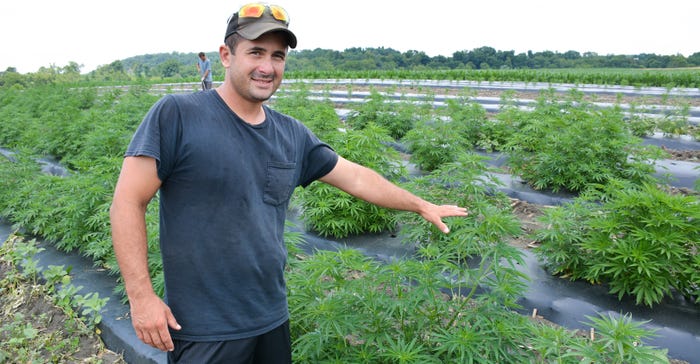
It’s the beginning of July and Bryan Harnish likes what he sees in his 3-acre hemp field.
“It’s going well so far,” he says. “We’ve been irrigating, fertigating … biweekly, and the crop’s taken off.”
This growing season is an experiment for Harnish. He’s trying hemp for the first time on his 600-acre grain and specialty crop farm in Pequea, Pa.
His success, or lack thereof will determine whether hemp is a good fit on his farm. He’s growing hemp for cannabidiol (CBD) production, and is trying three varieties: Youngsim 10, Stormy Daniels and Cherry Blossom. The plants are growing in 3-foot-wide plastic rows.
The first planting was done in early June; the second on June 21.
A good start
Harnish has been feeding the plants 150-pounds-an-acre of nitrogen and potash, along with other micronutrients.
“So, we’re trying to give them enough nutrients, give them plenty of water because we want as many buds as possible, as much weight as possible,” he says. "It's kind of a shot in the dark this year, we're making some educated guesses, but that's where we think we need to be based on what we know, what we read.”
Feminized plants are coveted for their buds, and this is the most important thing when it comes to CBD production. The first planting had many unfeminized plants, so Harnish has been culling the unfeminized, or male, plants by hand. At the same time, he’s been topping off the fast-growing plants to control growth. The second planting was all feminized seed.
Time to test
With all the growth he’s seeing, Harnish thinks it’s a good time to start some tissue testing to fine-tune his nutrient applications. It will help not only this year but in future years as he’s trying to optimize a system for his land.
He’s using Waypoint Analytical in Leola, Pa., for his tissue testing. The test costs around $20.
After that comes the most crucial tests: THC levels. Harnish is using PCR Labs in Allentown, Pa., to test for THC, likely in early August as he starts preparing for harvest. Timing a crop to see if it’s ready for harvest is crucial to avoid a plant getting “too hot” — higher than 0.3% THC. Once a plant gets over that 0.3% THC threshold, it must be destroyed according to federal and state law.
Learning on the go
Even though the plants have taken off, not everything has worked as planned. Walk through the rows of the first planting and it’s clear that some plants were culled early while others have struggled to grow.
Blame it on Roundup. One of Harnish’s helpers applied Roundup between the rows to kill some aggressive weeds. The problem was that the application was done on a windy day, hence some of the plants got some herbicide injury. So, it’s back to cultivating weeds with a hand hoe.
The rows between the second plantings are a little wider, too, compared to the first planting.
“The first planting was nonfeminized seeds, so we planted them closer together at 24 inches knowing we would be culling about half of them,” he says. “The second planting was 36 inches, just giving those plants a little more space.”
There’s been no disease pressure yet, and just a few white flies around the plants. This might change as the growing season continues. Harnish doesn’t plan on using herbicides or insecticides, but that might change if the disease and insect challenges get to be too much.
Of course, Mother Nature’s cooperation has been crucial.
“We've had optimal weather. A lot of rain but not too much. A fair amount of heat and humidity," he says. “So, it's been a nice growing season, and we're on a nice, well-drained field on top of the hills. We're getting plenty of air.
“We're cautiously optimistic. We've had some consultants coming out and saying we're on the right track.”
About the Author(s)
You May Also Like






